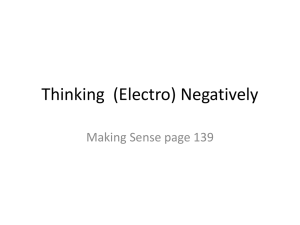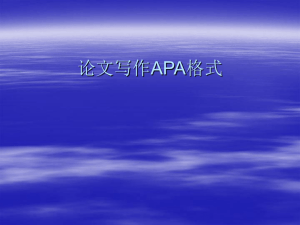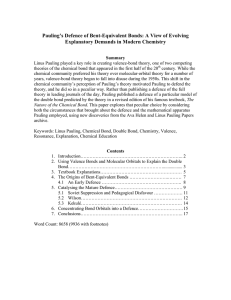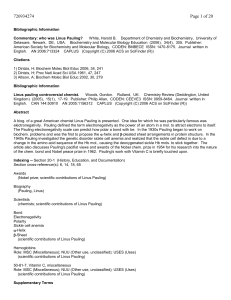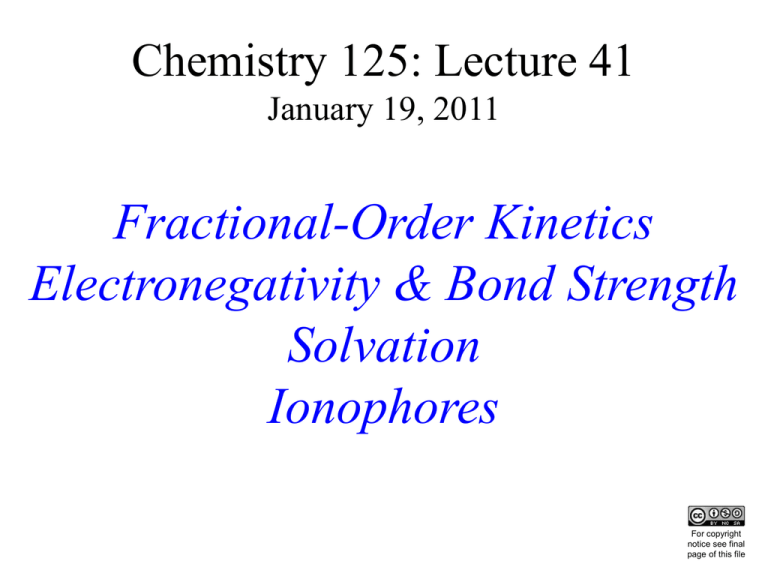
Chemistry 125: Lecture 41
January 19, 2011
Fractional-Order Kinetics
Electronegativity & Bond Strength
Solvation
Ionophores
This
For copyright
notice see final
page of this file
Generalization of Fractional-Order Kinetics
(suggestion by Ayesha)
Reaction of MeLi (pre-equilibrium)
(CH3Li)4 dominant
4 CH3Li
when Assoc = Dissoc [CH3Li]4 [(CH3Li)4]
1/4
[CH3Li] [(CH3Li)4]
reactive
Radical-Chain Initiator (steady state)
Union of Ideas
i.e. Progress
RO-OR
2 RO•
H-R’
ROH + •R’
when Term = Init [Rad•]2 [RO-OR]
H-X
prop
•X
H-R’ term
Number of “Machines” [RO-OR]1/2
X-X
X-R’
R’-R’
From 2009 Exam
3. Consider the chlorination reaction :
i-Pr2NCl + RH i-Pr2NH + RCl
and these approximate bond dissociation energies (kcal/mole):
N-Cl (46), R-Cl (85), N-H (92), R-H (100).
G. (3 min) Why should the BDEs of N-Cl and R-Cl be
so different, when those for N-H and R-H
are so similar?
Could e-Pair Repulsion Explain BDEs?
HO
OH
Total e-Density Contour (a0-3)
0.002
H2N
Cl
1.40 Å
0.01
1.73 Å
51
0.05
46
isoelectronic
isoelectronic
0.25
H3C
CH3
1.53 Å
Drawing proton(s) away from nucleus removes
BDE 90 kcal/mole OMO-OMO e-density from overlap region.
H3C
Cl
1.79 Å
84
Lone pair repulsion seems a plausible explanation
for weakening O-O vs. C-C or N-Cl vs. C-Cl.
But might electronegativity help explain
stronger C-Cl than N-Cl ?
C+ Cl-
from Wikipedia
Which Bond is Stronger N-Cl or C-Cl?
Electron Energy
Compared to What?
N-Cl stronger if forming Ions (N+ Cl-)
mismatch aids Heterolysis
•
Cl
•
•••
••
••
C
N
BDE
C-Cl stronger if forming Radicals (Cl • •C)
mismatch hinders Homolysis
separate
together
separate
by kind permission of the owners
First use in English (O.E.D.)
1837 J. D. Dana Syst. Mineral. 82 When chemistry
has so far advanced, that the relative electro-negativity,
(if I may so call it,) or electro-positivity, of the several
elements, is fully known,..we shall probably be able to
construct a natural arrangement of minerals on chemical
principles.
by kind permission of the owners
“Electronegativity”
and Bond Strength
Dana House
James Dwight Dana Benjamin Silliman Henrietta
Dana
Silliman
24
Hillhouse Avenue
1813-1895
1779-1864
1823-1907
1849
“Electronegativity”
and Bond Strength
Linus Pauling
1901-1994
http://nobelprize.org/
J. Am. Chem. Soc.
1932
Pauling was
pushing
resonance.
X-
H-X
“normal”
(average of
H-H and X-X)
Why not use
to measure
resonance
stabilization?
(electron volt = 23.06 kcal/mole)
in
H+
Pauling’s
theory
arithmetic mean
Observed
Pauling thought F-F was 65 kcal/mole.
Actually it is 38.
geometric mean
or A:B = (A:A * B:B)1/2
1932
Pauling was
pushing
resonance.
C-F – C-O ≠ O-F½
C-X
≠ polarity difference
O-O
O-F
OF ≠ (OO+FF)/2
BDE (obs)
“Normal”
[OF = (OO+FF)/2]
O-F polar “resonance stabilization”
~ additive!
(C-F½ – C-O½) ≈ O-F½
F-F
(units of electron volts)
(actually 1.65)
1932
Pauling was Relative to H & F
Relative to O
pushing
Relative to C
resonance.
HOAO node #
Relative to H
1.00
0.58
0.48
1.480.34
(screened) nuclear charge
Mapped to
a Distorted
Periodic Table
1932
Pauling was
pushing
resonance.
Is it surprising that bond strength
correlates with differences in
Pauling’s electronegativities, P?
No, his P scale was defined
by differences in bond strength.
pp. 26-28 Beyond the Bond
“More than ever before, new techniques show the
bond to be a convenient fiction, albeit one that holds
the field of chemistry together, finds Philip Ball.”
“By the 1960s, for all Pauling’s
salesmanship, MO theory was
generally agreed to be more convenient [than his resonance theory]
for most purposes.” .
Jan. 6, 2011 (International Year of Chemistry)
Pauling Electronegativity
Still we expect energy-mismatch
to strengthen bonds, so crude
correlation of P with IP and EA
is hardly surprising.
from Wikipedia
Mulliken Electronegativity (1934)
average of Atomic Ionization Potential and Electron Affinity
A
A+ + e
A
A+e
Free-radical halogenation introduces
a functional group (*) into alkanes.
Chemical & Physical
Properties of Alkyl Halides
Ionic Chemistry of * (SN & pKa)
X H
R :Nu
S
S
pK
1
2
N
N
a
Non-Bonded Interactions
and
Solvation (key for ionic reactions)
Premiers Éléments de Chimie ~1850
For chemical affinity to
act freely, substances must be
dispersed, and[ since dispersion
by mechanical pulverisation is
incomplete, they must be taken
into the liquid ]or gaseous state.
Previous chemists expressed
this fact by saying:
PV = nRT
Corpora non agunt,
nisi soluta
Henri Victor
Regnault
(1810-1878)
The theory of organic chemistry
became manageable because it is often
possible to focus on a simple unit with
strong interactions (molecules & bonds with well
defined geometry and energy), neglecting the much
weaker (and more numerous and complex)
intermolecular interactions.
But the weak intermolecular interactions give organic materials many
of their most valuable properties.
Non-Bonded “Classical” Energies
+
R
-
Charge-Charge
R-1
(Coulomb’s Law)
The ONLY source of
true chemical potential energy.
E±Coulomb = -332.2 kcal/mole / dist (Å)
dielectric constant
Solubility of NaCl
vs. Me4NI?
NaCl (mp 801°C)
vs.
CsI (mp 621°C)
H 2O
78
(CH3)2S=O
49
CH3OH
33
CH3CH2OH
25
(CH3)2C=O
21
CHCl3
5
(CH3CH2)2O
4
n-hexane
2
(e.g. J&F Table 6.7 p. 239)
(gravity & magnetism are for wimps;
[long-range attraction; contrast radical bonding]
the “strong force” is for physicists)
Non-Bonded “Classical” Energies
+
-
+
+
-
R
R-1
-2
R-4
T
R-3
What if the dipole orientation is not fixed?
- ++
+
Charge-Charge
(Coulomb’s Law)
Charge-Dipole
(Dipole Moment)
Charge-Induced Dipole
(Polarizability)
Nonpolar
-
-
+
-
+
+
+
-
R-3
Dipole-Dipole
R-6
Induced-Induced
(Dipole Moments)
(Cf. Correlation Energy)
The latter interactions are weak because dipoles moments and polarizabilities
are small - and because the energies fall off rapidly with increasing distance.
Halide Trends (e.g. J&F sec. 6.2)
van der Waals
Radius of X (Å)
Bond Distance
of X-CH3 (Å)
2
Dipole Moment
of X-CH3
i.e. non-bonded distances are Debye units = 4.8
(electrons)
about twice bonded distances. charge
separation (Å)
1
Non-monotonic conflicting nonlinear trends
The dipole moment () is the product of two properties, with
opposing trends. Both are monotonic, but one is nonlinear.
0
H
F
Cl
atom
Br
I
“Charge” of
X , CH3 (e)
= Debye / (4.8 dist)
(monotonic)
Halide Trends (text sec. 6.2)
van der Waals
Radius of X (Å)
Bond Distance
of X-CH3 (Å)
compare
CH3
2
!
1
0
Non-monotonic,like (suggests competition)
“A-Value” of X
Eaxial-Eequatorial
larger vdW radius
(kcal/mol)
stands off further
another measure
H
F
Cl
atom
Br
I
of substituent “size”
from J&F
Boiling points
(Table 6.2)
0
1.85
1.87
1.81
1.62
CH4 is
not polar
and not very
polarizable
-
+
+
+
-
+
+
-+
polarizability,
not just polarity
from Carey & Sundberg
-
End of Lecture 41
Jan. 19, 2011
Copyright © J. M. McBride 2011. Some rights reserved. Except for cited third-party materials, and those used by visiting
speakers, all content is licensed under a Creative Commons License (Attribution-NonCommercial-ShareAlike 3.0).
Use of this content constitutes your acceptance of the noted license and the terms and conditions of use.
Materials from Wikimedia Commons are denoted by the symbol
.
Third party materials may be subject to additional intellectual property notices, information, or restrictions.
The following attribution may be used when reusing material that is not identified as third-party content:
J. M. McBride, Chem 125. License: Creative Commons BY-NC-SA 3.0
Puzzle Answer(s)
B
H
O
R
CH2
H
free-radical
chain
Note: the base that removes H+ could be a
very weak one, like ROH or HSO4-.
R
O
O
CH
(might fail with
30% H2SO4)
elimination
Cl
H-O+
i-Pr
R
H-O
CH2
N
H
Cl
R
CH
H
i-Pr
C
H
Cl
HOMO-LUMO
nO
*N-Cl
H + i-Pr
N
i-Pr
Cl
R
elimination
R
O
CH
H + i-Pr
N
i-Pr
H
H
B




